In a surprising yet strategic maneuver, Intel and AMD, two of the most significant players in the semiconductor industry, have recently announced a partnership to form an x86 ecosystem advisory group. This collaborative effort comes as both companies face mounting competition from Arm, a competitor that has been rapidly gaining ground in recent years. Instead of continuing their historical rivalry, Intel and AMD are joining forces to address the challenges posed by a rapidly evolving technology landscape. This alliance seeks to enhance software compatibility across platforms and reaffirm the importance of the x86 architecture that has served as the backbone of personal computing since its inception in the 1970s.
During the OCP Global Summit held in California, the two companies unveiled their plans to create this advisory group, which will bring together an impressive lineup of additional partners, including prominent entities such as Lenovo, Dell, Google, HP, Microsoft, and Meta. Their collective goal is to chart a course forward for the x86 architecture amidst a competitive environment increasingly influenced by the versatility and efficiency of Arm’s offerings.
As we move into 2024, the landscape of computing is becoming ever more complex. Arm chips, such as Apple’s M-series and Qualcomm’s Snapdragon X-series, have gained immense popularity due to their accessibility and performance. The recent launch of the octa-core Snapdragon X Plus, for instance, has brought the price of Arm-powered devices below $800, making them an attractive option for consumers.
This shift is not merely a passing trend; research by Grand View Research anticipates that the market size for Arm-based servers will reach approximately $5.84 billion in 2023, with projections indicating a robust compound annual growth rate (CAGR) of 14.3% from 2024 to 2030. The growing adoption of Arm’s architecture implies that Intel and AMD can no longer afford to operate solely as rivals; rather, they must cooperate to ensure the sustainability and future relevance of their x86 architecture, particularly as they cede market share.
The formation of the x86 ecosystem advisory group introduces a tangible effort to improve software compatibility across AMD and Intel processors. A central goal of this initiative is to create a more unified set of instructions and architectural interfaces, bolstered by feedback from the x86 hardware and software communities. This ensures that both established software and emerging technologies can function seamlessly across different x86-based platforms, which has historically been an area of concern in contrast to Arm’s mandated compatibility across its architecture.
Notably, the advisory group’s founding members include industry heavyweights like Dell, Broadcom, Lenovo, and Oracle, alongside key figures such as Linux kernel creator Linus Torvalds and Epic Games CEO Tim Sweeney. Their involvement signals a commitment to fostering collaboration and innovation in the x86 space, ensuring that the architecture continues to evolve alongside modern computing needs.
If this initiative proves successful, it could herald a significant transformation in software compatibility for various x86 platforms, including PCs, data centers, and cloud computing environments. Enhanced compatibility would not only streamline the development process but also expedite the adoption of new features and technologies across an increasingly diverse range of devices.
Commenting on this pivotal moment, Intel CEO Pat Gelsinger emphasized that we are on the verge of a monumental shift within the x86 ecosystem, one that is necessary to meet the demands of current and future customers. His counterpart at AMD, Lisa Su, echoed this sentiment, highlighting the necessity for the x86 architecture to evolve as a computation platform preferred by developers and customers alike.
The formation of the x86 ecosystem advisory group encapsulates a crucial turning point for Intel and AMD, as they pivot away from a purely adversarial relationship toward collaborative innovation. As the chipmaking industry continues to evolve rapidly, with emerging technologies and changing consumer expectations, the partnership’s success could serve as a model for future collaborations among competitors.
The partnership between Intel and AMD not only signifies a commitment to the evolution of the x86 architecture but also emphasizes the industry’s need to adapt to the changing technological landscape. Only time will reveal if this alliance will indeed guard the x86 legacy against the growing influence of Arm, but one thing is clear: the stakes have never been higher.


Leave a Reply